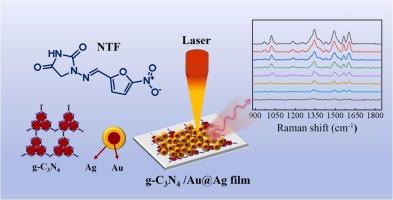A SERS sensor of g-C3N4/Au@Ag thin film for detecting nitrofurantoin residues in honey
IF 6.3
2区 材料科学
Q2 CHEMISTRY, PHYSICAL
引用次数: 0
Abstract
Detecting antibiotic residues in food is a critical challenge for food safety assurance. This study developed a surface-enhanced Raman scattering (SERS) sensor based on two-dimensional graphitic carbon nitride (g-C3N4) loaded with Au@Ag core-shell nanostructures (g-C3N4/Au@Ag) for detecting nitrofurantoin (NFT) residues in honey. The g-C3N4/Au@Ag thin film was fabricated by sequentially depositing g-C3N4 nanosheets, Au nanoparticles, and Ag nanoparticles onto a stainless steel substrate via an electrochemical deposition method. This SERS sensor could synergistically amplify SERS signals by combining the localized surface plasmon resonance (LSPR) from the Au@Ag nanostructures with the charge transfer between the g-C3N4 semiconductor and Au@Ag nanostructures. The optimized SERS sensor achieved an exceptional SERS enhancement factor of 3.8×106 for NFT in aqueous solutions, with a limit of detection (LOD) of 0.72 nM. Moreover, this SERS sensor could also recognize NFT residues in honey matrices at an LOD of 5 nM. These results provide a novel strategy for the highly sensitive detection of antibiotic residues in food safety monitoring, highlighting its potential for rapid screening of NFT residues in food.

g-C3N4/Au@Ag薄膜SERS传感器检测蜂蜜中呋喃托因残留
检测食品中的抗生素残留是食品安全保障的一个重要挑战。本研究开发了一种基于负载Au@Ag核壳纳米结构(g-C3N4/Au@Ag)的二维石墨氮化碳(g-C3N4)表面增强拉曼散射(SERS)传感器,用于检测蜂蜜中呋喃托因(NFT)残留。采用电化学沉积的方法,将g-C3N4纳米片、Au纳米颗粒和Ag纳米颗粒依次沉积在不锈钢衬底上,制备了g-C3N4/Au@Ag薄膜。该传感器通过结合来自Au@Ag纳米结构的局部表面等离子体共振(LSPR)和g-C3N4半导体与Au@Ag纳米结构之间的电荷转移来协同放大SERS信号。优化后的SERS传感器对水溶液中NFT的SERS增强因子为3.8×106,检测限(LOD)为0.72 nM。此外,该SERS传感器还可以在5 nM的LOD下识别蜂蜜基质中的NFT残基。这些结果为食品安全监测中抗生素残留的高灵敏度检测提供了一种新的策略,突出了其快速筛选食品中NFT残留的潜力。
本文章由计算机程序翻译,如有差异,请以英文原文为准。
求助全文
约1分钟内获得全文
求助全文
来源期刊

Journal of Alloys and Compounds
工程技术-材料科学:综合
CiteScore
11.10
自引率
14.50%
发文量
5146
审稿时长
67 days
期刊介绍:
The Journal of Alloys and Compounds is intended to serve as an international medium for the publication of work on solid materials comprising compounds as well as alloys. Its great strength lies in the diversity of discipline which it encompasses, drawing together results from materials science, solid-state chemistry and physics.
 求助内容:
求助内容: 应助结果提醒方式:
应助结果提醒方式:


